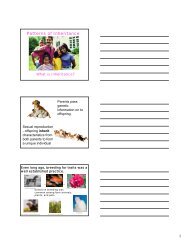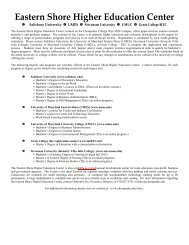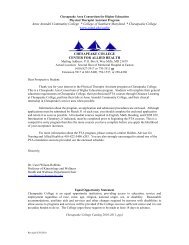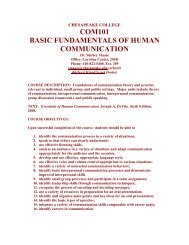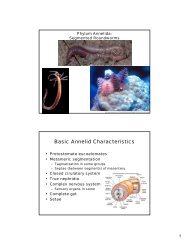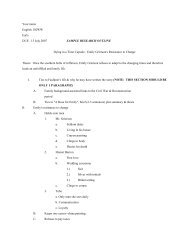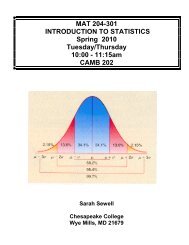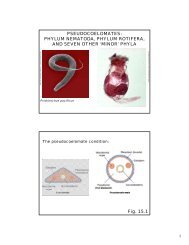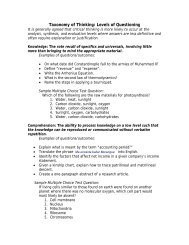PHYLUM CHORDATA
PHYLUM CHORDATA
PHYLUM CHORDATA
Create successful ePaper yourself
Turn your PDF publications into a flip-book with our unique Google optimized e-Paper software.
<strong>PHYLUM</strong> <strong>CHORDATA</strong><br />
5 DEFINING SYNAPOMORPHIES<br />
1. Notochord: dorsal support rod<br />
2. Pharyngeal gill arches and slits/pouches<br />
3. Dorsal, hollow nerve cord<br />
4. Post-anal tail<br />
5. Endostyle<br />
(or thyroid)<br />
These may only be<br />
present in the embryo!<br />
SUB<strong>PHYLUM</strong> URO<strong>CHORDATA</strong><br />
Class Ascidiacea: tunicates (“sea squirts”): sessile<br />
filter-feeders<br />
Body is protected by thick tunic: cellulose(!) and<br />
toxic minerals from seawater<br />
www.nature.com/.../slideshow/ nrg0601_458a_F3.html<br />
1
SUB<strong>PHYLUM</strong> URO<strong>CHORDATA</strong><br />
Class Thaliacea: salps: planktonic filter-feeders<br />
with transparent, gelatinous bodies<br />
www.solaster-mb.org/mb/tunicata.htm<br />
http://www.mbari.org/midwater/pseudusa/ms-figures/Fig3_sm.jpg<br />
2
SUB<strong>PHYLUM</strong> URO<strong>CHORDATA</strong><br />
Class Larvacea: salps: planktonic filter-feeders<br />
with transparent, gelatinous bodies<br />
jellieszone.com/oikopleura.htm<br />
http://www.mbari.org/midwater/pseudusa/ms-figures/Fig3_sm.jpg<br />
SUB<strong>PHYLUM</strong> CEPHALO<strong>CHORDATA</strong><br />
Lancelets: benthic filter-feeders capable of<br />
swimming<br />
Have notocord and all other characteristics as adult<br />
3
SUB<strong>PHYLUM</strong> VERTEBRATA<br />
Vertebrates: animals with backbones<br />
Living endoskeleton, paired appendages, strong<br />
cephalization<br />
Good fossil history, as bones fossilize well<br />
www.mun.ca/biology/scarr/Phylogeny_of_Fish.htm<br />
4
universe-review.ca/R10-19-animals.htm<br />
Ostracoderms…<br />
www.zoology.ubc.ca/courses/bio204/lab6_photos.htm<br />
http://cas.bellarmine.edu/tietjen/images/ostracoderm3.jpg<br />
5
…and myxiniforms<br />
(lampreys and hagfishes).<br />
Primitive vertebrates like<br />
this lamprey have (had) 7<br />
gill arches and pouches.<br />
They were jawless, and<br />
instead possessed a<br />
circular or slitlike mouth.<br />
Placoderms are the<br />
first group to show<br />
the evolution of<br />
jaws…<br />
http://cas.bellarmine.edu/tietjen/images/placoderm_330_mybp.jpg<br />
www.zoology.ubc.ca/courses/bio204/lab6_photos.htm<br />
…derived from<br />
the first gill<br />
arch.<br />
http://palaeo.gly.bris.ac.uk/palaeofiles/lagerstatten/Gogo/fauna.html<br />
6
Only one existing animal has 6 arches: the six-gill<br />
shark. It is restricted to deep water (>1000 ft).<br />
http://www.stanleysubmarines.com/animal_files/sixgill.jpg<br />
www.mun.ca/biology/scarr/Phylogeny_of_Fish.htm<br />
7
Agnatha<br />
Lampreys and Hagfishes<br />
Modified after http://whozoo.org/fish/fishtaxa.htm<br />
universe-review.ca/R10-19-animals.htm<br />
8




